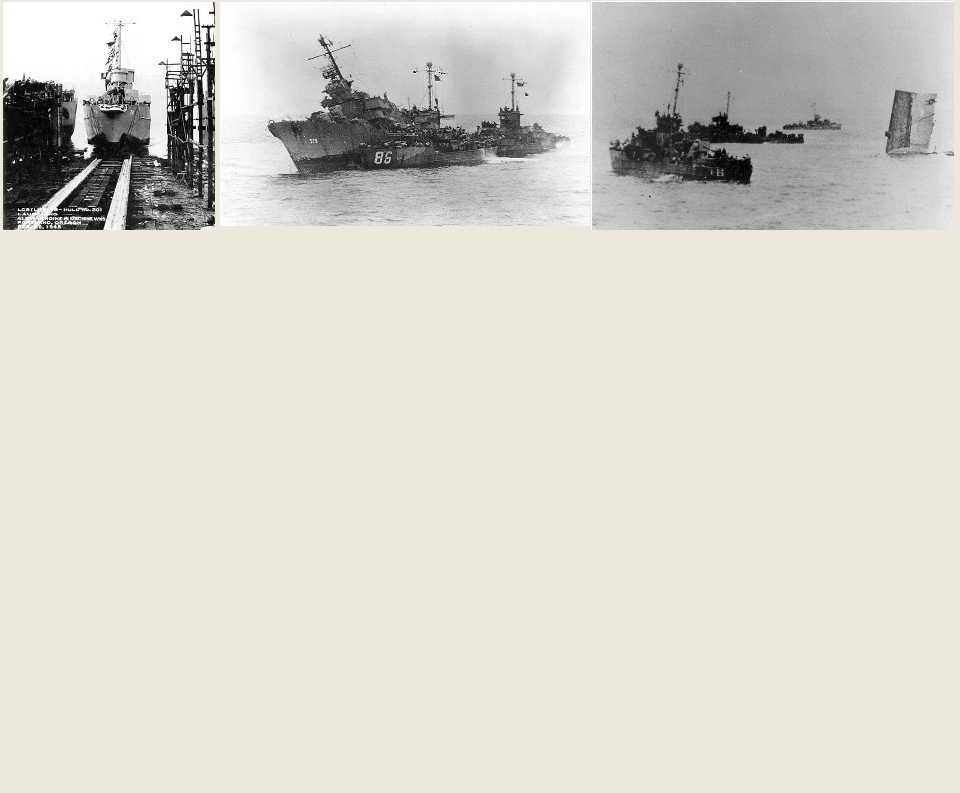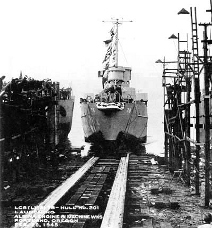|
|



.jpg)
.jpg)

Landing Craft Support (Large) ships were developed to support amphibious landings and to intercept inter-island barge traffic. Used solely in the Pacific Theater of operations, they were a further development of gunboats that had been converted from Landing Craft Infantry ships - LCIs. The need for a close-fire support vessel was demonstrated during the assault on Tarawa on 20 November 1944. After the larger ships had shelled the beaches and landing zones to disrupt enemy defense efforts, the landing craft headed for shore to deliver the troops. During the time that the naval bombardment had stopped and the troops had landed, the enemy had time to regroup, and the effect on the Marines was deadly. In order to deliver fire support to protect them, a new type of vessel was necessary. It needed the ability to get in close to shore and had to have sufficient armament to support the landings. Previous experiments had resulted in placing additional guns, rockets, and mortars on various LCI(L)s and turning them into gunboats. These LCI(G), LCI(R), and LCI(M) variations had proven their worth, but were still limited because of their original configuration. They were considered to be an interim solution the problems encountered in the Pacific Theater. Fortunately, a more advanced gunboat had been in the planning stages as early as 1942, and the first contracts for the new fire support vessel had been awarded in 1943. The first of these gunboats, the LCS(L) 1, was launched on 15 May 1944 at the George Lawley and Sons Shipyard in Neponset, Massachusetts. Using the existing plans for the LCI hull, the Lawley yard had designed a new fire support ship, one that was not a modified troop carrier but a true fighting ship. The result was the Landing Craft Support (Large) or LCS(L). Packed with firepower, the LCS(L)s had two twin 40mm guns, four 20mm guns, and four .50 caliber machine guns. Mounted in the bow was one of three guns, either a single 3"50, a single 40mm, or a twin 40mm. Just aft of the bow gun were ten Mark 7 rocket launchers. One writer described LCS(L)s as the most heavily armed of the World War II gunboats, and still another claimed that they looked like the Fourth of July fireworks when they were leading an assault. One hundred thirty LCS(L)s were produced by three shipyards. In Neponset, Massachusetts, the Lawley shipyard produced 47. In Portland, Oregon, the Albina Engine and Machine Works produced 31 and Commercial Iron Works produced 52. LCS(L)s were usually involved in the first assault on the beach. Attacking the beach in a line, they made two runs, firing rocket barrages at 1000, 800, and 500 yards. After the third rocket barrage, they turned broadside to the beach and fired on targets of opportunity before heading seaward for the next run. On the third run, they were followed by the landing craft. As they approached the shore, they slowed to allow the troop-laden boats to pass by and deposit their men on the beaches. The LCS(L)s then continued to fire over the heads of the troops and remained inshore, firing on targets as they became available. On some occasions, they took Marine or Army artillery spotters on board for assistance in locating enemy targets on shore. They were active in the campaigns for the Philippines, Iwo Jima, Okinawa, and Borneo. After the war, the ships served in mine sweeping operations around the Japanese islands, Korea, Taiwan, and other locations in the Far East. By early 1946, most of the ships had returned to the states and been placed in reserve at Green Cove Springs, FL, or Astoria, WA. In 1949, the LCS(L)s still on duty in the U.S. Navy were reclassified as LSSLs, or Landing Ship Support Large. In the early 1950s, a number of LCS(L)s were lent to our allies, with fifty-three of them going to Japan to serve in the Japanese Maritime Self Defense Forces. Still others were lent to the French and eventually the Vietnamese for use in Indochina. Other countries that received LCS(L)s were Italy, Greece, Korea, Thailand, Taiwan, and the Philippines. |
History of the Mighty Midgets |
LCS History |
Copyright 2009 Acme Rockets 12345 Street Address Cityname, ST or Province 12345 |
Website Themes by CoffeeCup Software |